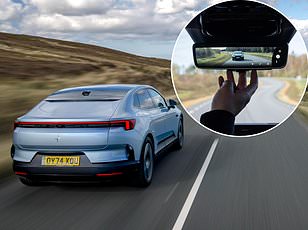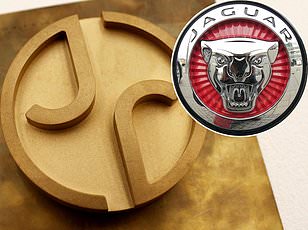Jaguar is not looking back on its radical rebrand... quite literally: British car maker teases concept EV with NO REAR WINDOW
- Design Vision Concept hints Jaguar's EVs will have rear-view cameras instead
Jaguar has shifted up another gear with its controversial rebrand by teasing a first glimpse of its radical new electric concept car - and it doesn't have a rear window.
The British firm is - quite literally - not looking back on its bold and daring new company direction revealed this week as it is set to follow in the tyre tracks of EV rival Polestar in contentiously ditching the traditional glass rear window in its future models in favour of a rear-facing camera linked to a digital interior mirror.
Teaser images, released by Jaguar and members of its brand strategy team on social platforms, show a section of the rear quarter and pop-out cameras that will feature on the upcoming 'Design Vision Concept', which is being unveiled in Miami on 2 December.
The EV, which appears to have enormous proportions, a remarkably wide and flat body and bulging rear wheel arches, will signal the design language of Jaguar's first trio of next-generation battery cars that spearhead its rebirth as an all-electric premium motor company from 2026.
Its flat body panels have drawn comparisons to Tesla's Cybertruck, which itself is one of the most controversial models to enter the market in recent history.
Jaguar's choice to omit a conventional rear window for its future EVs threatens to heave even more public criticism in the company's direction, with infuriated petrolheads taking to social media in recent days to describe its advertising campaign and decision to ditch the classic roaring cat badge as 'woke' and 'unhinged'.

Jaguar is - quite literally - not looking back on its controversial rebrand: The British car maker, which has hit headlines this week with a radical new company identity, has provided a first glimpse of its dramatic new electric concept vehicle being unveiled early next month. And, contentiously, it doesn't have a rear window
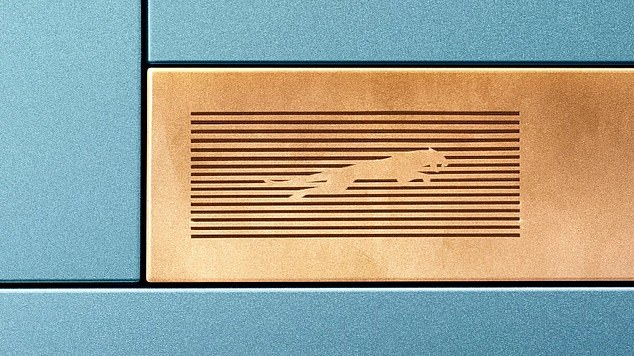
Jaguar's head of global brand strategy and insight, Richard Green, shared images of a pop-out panel on the concept car
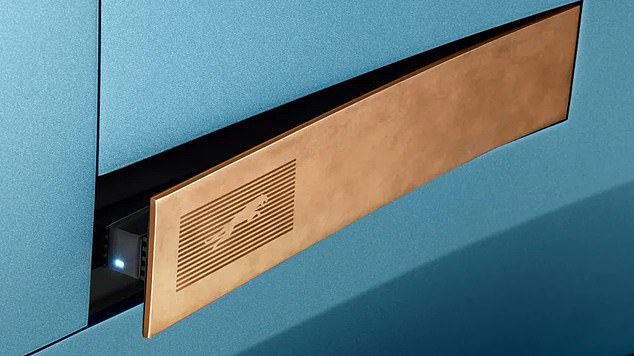
The panel, which features the new IBM-inspired Jaguar leaper logo, appears to conceal a rear-facing camera, which would send an image to a digital rear-view camera to compensate for drivers not having a rear window
An image of the rear section posted on official Jaguar channels on Wednesday evening hints at a very wide concept vehicle with a dramatic body combining smooth curves and hard-edged straight elements.
The prototype's design will take influence from Jaguar's new logos, which were unveiled on Tuesday as part of the firm's media blitz to signal its change in identity.
Prominent across the vehicle's rear section is a panel of straight slats, which mirror those backing the new 'leaper' logo showcased earlier in the week, which Jaguar says was inspired by IBM's trademark emblem.
It is unclear if the rear light cluster will be incorporated into these slats or if they are separate on a section of the Jaguar's tail that's out of sight in the image shared by the 90-year-old car maker.
Another two images, which were shared on LinkedIn by Jaguar's head of global brand strategy and insight, Richard Green, on Thursday, show a pop-out panel that again features the reimagined leaper stamp.
It appears to conceal the rear-facing camera, as the brand looks destined to ditch conventional mirrors and glass rear window panels.
While the conversation-triggering teaser image posted to social media on Wednesday was accompanied by the words 'copy nothing' - reiterating the mantra of JLR company founder William Lyons - many will argue that Jaguar will in fact be mimicking one of its biggest rivals.

Prominent across the concept vehicle's rear section is a panel of straight slats, which mirror those backing the leaper logo showcased earlier in the week
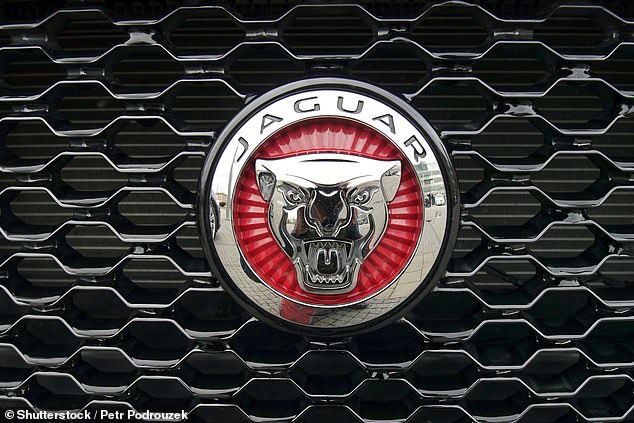
The classic Jaguar 'growler' logo has been ditched as the car firm reinvents itself to appeal to a younger audience of car buyers
Polestar, itself a progressive electric car company with a fashion-influenced and cinematic advertising campaign, earlier this year launched its landmark Polestar4 - the first UK car ever sold without a rear window.
Design bods at the Chinese-owned car firm - which is a spin-off of Volvo - said they opted to dispense with the rear glass to provide more headroom for passengers sat in the back.
To compensate, the 4 gets a high-definition roof-mounted camera to provide the driver with a view of what's lurking behind.
This is linked to a digital rear-view mirror, which can also be switched to a conventional glass mirror for when drivers need to keep an eye on children squabbling in the back seats.

The Polestar 4 - the third car from the Swedish EV brand - is the first car without a rear window to arrive on UK road. Jaguar looks set to be going in a similar direction by ditching the glass in its future EV models, if the Design Vision Concept is anything to go by

Polestar's 4 has no rear window to provide more headroom for rear passengers. Instead of glass, it uses a roof-mounted high-definition camera that links to a digital mirror on the windscreen

The rear-view digital mirror is also two-way so you can switch it to a regular mirror to check on rear passengers – a must if you have kids
This is Money's Freda Lewis-Stempel drove the Polestar4 in October and said: 'For the most part, I really didn't miss or feel hampered by the lack of a rear window during my driving stint.
'The HD camera worked very well; it was sharp and clear, and the wide dynamic range picked up far flung angles. Looking in the electronic rearview mirror was a one-for-one swap and, honestly, I forgot that it was a camera mirror for most of the driving.
'It was only when pulling out at junctions and reversing into parking spaces that I remembered there was no glass having glanced over my shoulder.
'But even with parking or reversing, many of us are - rightly or wrongly - so used to using cameras these days that there wasn’t much difference to my actions in any other new motor. You couldn’t do the extra check behind, but it wasn’t the end of the world.
'You should also remember that many van and lorry drivers do without a rear window - and they mostly manage just fine.
'I should say, though, that I don’t wear glasses, so bespectacled drivers definitely need to give the camera mirror a proper trial when test driving.'
While a camera-based system replacing a rear window appears to work in practice, plenty of drivers will argue it is an unnecessary move to fix a problem that simply doesn't exist.
Adopting the tech is also likely to drive up manufacturing and vehicle prices, as well as open the door to additional electrical gremlins which, if the camera and digital mirror were to rear their ugly head and stop working, could potentially cause an avoidable safety risk.

The concept will be shown in full on 2 December (3 December UK time) at Miami Art Week. It will preview the four-door electric GT first seen - heavily camouflaged - at the beginning of its rigorous testing regime last week

The four-door 'Grand Tourer' is one of an all-new three-EV line-up due from 2026. The production car is expected to produce more than 575bhp and have a battery range to cover in excess of 430 miles

Prices will start above £100,000 - almost double the average cost of a new petrol or diesel Jaguar in 2024 - and see Jaguar go head-to-head with EV heavyweights including the Audi e-tron GT, Mercedes EQS, Porsche Taycan and Tesla Model S
While traditionalists are likely to be unhappy with this latest move, it appears upsetting former Jaguar buyers is not a major concern for the firm's executives.
Bosses have said this week that they expect to lose the vast majority of the company's existing customer base as a direct result of its new brand identity and switch to only electric vehicles.
Managing director Rawdon Glover told us that 85 per cent of future clients would be new to the Jaguar brand as it looks to target a much younger audience.
Only 15 per cent – around one in seven – of buyers from 2026 onwards are expected to be existing customers. This is the 'scale of the transformation', he said.
While optimistic about the brand's future, Glover also conceded that there is 'no Plan B'.
'We think it is going to be a success,' he told This is Money.
'There are a lot of people out there who have not got Jaguar on their shopping list. We have to persuade and convince them.'
Glover also stressed they had to be 'fearless', adding: 'This is a complete reset. Jaguar is transformed to reclaim its originality and inspire a new generation.'

Jaguar managing direction Rawdon Glover (left) says the ambitious EV move and rebrand won't appeal to 85% of the company's existing customers. Instead, it is aiming for a younger client base

Gerry McGovern, Jaguar's chief creative officer, is unapologetic over the redesign. He said yesterday: 'It will make you feel uncomfortable. That's fine'
JLR design boss, Jerry McGovern, who has previously penned the new Land Rover Defender as well as the latest Range Rover and smaller Range Rover Evoque, added: 'We are creating Jaguar for the future, restoring its status as a brand that enriches the lives of our clients and the Jaguar community.'
Discussing the new direction, McGovern has been unapologetic about courting controversy with the rebranding and restyling of Jaguar: 'It will shock, surprise and polarise,' he told This is Money.
'It will make you feel uncomfortable. That's fine. The world is not standing still.'
His aim was to 'amplify our unique British heritage' in a modern 21st century manner.
Speaking at a briefing at JLR's design centre at Gaydon in Warwickshire, he said he wanted to create the same stir that the E-Type created in the 1960s: 'The brief I set was to be jaw-dropping.'
He went on: 'This has been years in the making. It's not just about reshaping a car. It's about redefining and reimagining a brand. It's about reimagining Jaguar. This is big,' before jokingly promising: 'We have not been sniffing the white stuff.'
JLR CEO Adrian Mardell has described Jaguar’s rebirth as 'something spectacular'.
The concept will be shown in full on 2 December (3 December UK time) at Miami Art Week.
It will preview the four-door electric GT first seen - heavily camouflaged - at the beginning of its rigorous testing regime last week.
Jaguar's next-generation electric four-door 'Grand Tourer' is one of an all-new three-EV line-up due from 2026.
The production car is expected to produce more than 575bhp and have a battery range to cover in excess of 430 miles.
Prices will start above £100,000 - almost double the average cost of a new petrol or diesel Jaguar in 2024 - and see Jaguar go head-to-head with heavyweights including the Audi e-tron GT, Mercedes EQS, Porsche Taycan and Tesla Model S.

Jaguar's new rebrand has attracted accusations the company has gone 'woke' - as it launched the new look with an advert featuring no cars
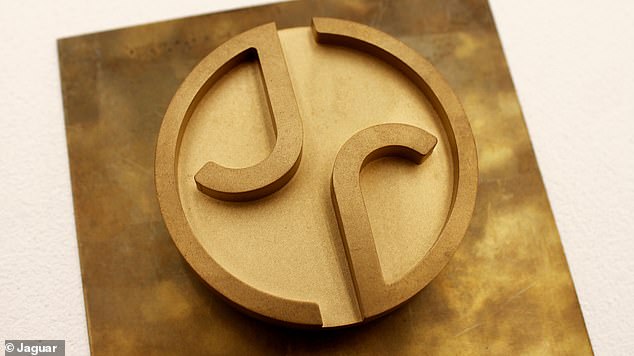
This is the new Jaguar logo - a roundel made up of the letter 'J' that looks the same both ways up

The company already showcased its new Jaguar logo typography featuring largely lower case letters - save for a single capitalised 'G' - in what the company is calling a 'complete reset'

The 'growler' logo, the universally recognised snarling Jaguar head badge used for decades on the grilles and bonnets of iconic cars including the E-Type, has fallen victim to a revamping of the firm's style and identity as it seeks out younger customers
Jaguar's rebrand hits headlines... and not for the right reasons
Jaguar audacious rebrand launched this week - reportedly the brainchild of a team of 800 marketing and advertising folk - has caused a major public stir.
Customers and car fans have been angered by the company's decisions to ditch its classic iconography, including the 'growler' badge depicting a roaring big cat that has graced iconic cars from its past - notably the E-Type.
The company's fresh direction also included a questionable advertising campaign, with a video that features precisely no cars and a techno music soundtrack and the slogans 'create exuberant', 'live vivid', 'delete ordinary' and 'break moulds'.
The new look sparked a furious reaction in recent days.
'Congratulations,' weighed in one commenter on Jaguar's Instagram. 'You've killed a British icon.' 'Hello, thanks for the feedback! We’ll be sure to pass it onto the team. Best wishes,' the firm said to many of its detractors on social media.
'Go woke, go broke,' wrote several people in tweets to the firm. 'Go hard,' Jaguar fired back.
Responding to an almost accusatory tweet reading 'I thought you guys made cars??', the firm's social media team simply said: 'We do. All will be revealed.'
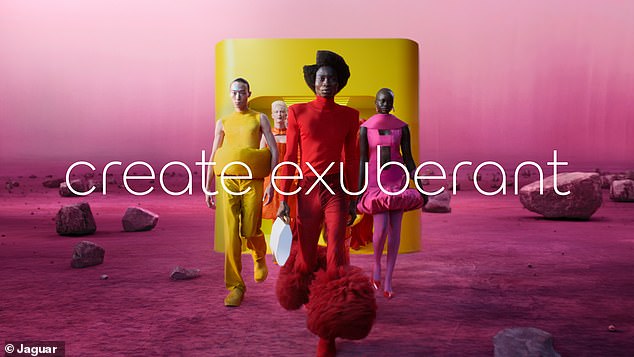
Jaguar has unveiled its new 'brand' look with a technicolour advertisement that features precisely no cars

Jaguar has been accused of going 'woke' by car fans on social media - but responses from the firm suggest it is not bothered by the reaction


Jaguar has given short shrift to the outrage on social media - and even invited Elon Musk, boss of direct rival Tesla, to the launch event for its new concept car in Miami

Even Tesla CEO Elon Musk got in on the act, asking the firm via his X platform: 'Do you sell cars?'
Jaguar replied warmly, inviting him to the launch event for its new concept car at Miami Art Week.
It said: 'Yes. We'd love to show you. Join us for a cuppa in Miami on 2nd December?'
The bold new strategy and brand identity is a significant pivoted away from the qualities that made Jaguar distinctly British.
This includes discarding its associations with the stoicness of Inspector Morse in his red Mk2, or Ben Kingsley, Mark Strong and Tom Hiddleston purring that villains 'all drive Jaguars' in a (now banned) TV advert.

Jaguar has long been associated with the likes of Inspector Morse (as played by John Thaw, above) - rarely seen without his iconic Mk2


The Jaguar E-Type - a stone-cold design classic (left) - and its spiritual successor the F-Type (right) are now consigned to the past
The radical move is part of Jaguar's complete reimagination as it races ahead of the 2030 deadline for car firms to stop selling petrol and diesel cars in the UK.
It had already promised to become an 'exclusive premium EV brand' from 2026, doing away with the internal combustion engine it has relied upon for nine decades, some four years earlier than the Government intends to ban sales of new combustion cars.
Saying it will start with a 'clean sheet', the company has already set about resetting its social media platforms, with Instagram now showing just two posts to the company's 17million followers: these being the concept teaser image and the daring advertisement.
Its new advertising campaign has drawn comparisons to the legendary Silk Cut cigarette adverts, which featured no cigarettes. The tobacco brand famously sponsored Jaguar's most iconic race car, the XJR-9, which won the 24 Hours of Le Mans in 1988.
While many have blasted the liberal ad for not featuring a single car, it is at least an accurate depiction of the auto company's current position.
Jaguar has already withdrawn from the UK car market and said it will not offer any new models for 12 months as part of a 'sunset period' it says was a strategic decision to create a 'fire break' for dealers and customers to prepare for its electric rebrand.
Production of right-hand-drive UK cars has already ended, though its biggest model - the F-Pace SUV - is still being built for overseas markets, while the electric E-Pace remains available to 'corporate clients into 2025'.


